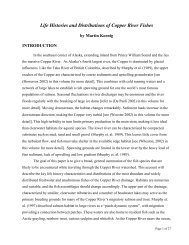Mitigation for the Construction and Operation of Libby Dam
Mitigation for the Construction and Operation of Libby Dam
Mitigation for the Construction and Operation of Libby Dam
You also want an ePaper? Increase the reach of your titles
YUMPU automatically turns print PDFs into web optimized ePapers that Google loves.
Burbot per Trap Day<br />
3<br />
2.5<br />
2<br />
1.5<br />
1<br />
0.5<br />
1995-2003<br />
Model<br />
Y = -0.387 + 4.014*X<br />
r 2 = 0.47; p = 0.04<br />
0<br />
0 0.1 0.2 0.3 0.4 0.5 0.6<br />
Catch per Net<br />
Figure 39. The relationship between mean burbot catch per net <strong>for</strong> spring sinking gillnets on<br />
<strong>Libby</strong> Reservoir <strong>and</strong> burbot catch rates (fish/trap day) <strong>of</strong> baited hoop traps in <strong>the</strong> stilling<br />
basin below <strong>Libby</strong> <strong>Dam</strong> 1995-2003.<br />
Total Fish Abundance<br />
The long-term trends in total fish abundance in <strong>the</strong> reservoir reflect <strong>the</strong> changes that<br />
have occurred in <strong>the</strong> reservoir since impoundment. Total catch (fish per net) <strong>for</strong> spring gillnets<br />
has significantly increased since impoundment (Figure 40; r 2 = 0.104; p = 0.09; Table 9) is<br />
indicative <strong>of</strong> an increase in <strong>the</strong> biomass <strong>of</strong> species that prefer reservoir habitats: peamouth<br />
chub, suckers, nor<strong>the</strong>rn pikeminnow, etc. However, <strong>the</strong>re is no significant trend in total catch<br />
(fish per net) <strong>for</strong> fall gillnets (Figure 40; r 2 = 0.003; p = 0.76; Table 10). Species composition<br />
<strong>for</strong> <strong>the</strong> catch <strong>of</strong> fall <strong>and</strong> spring gillnets has remained relatively stable since 1988 (Table 11).<br />
100
















